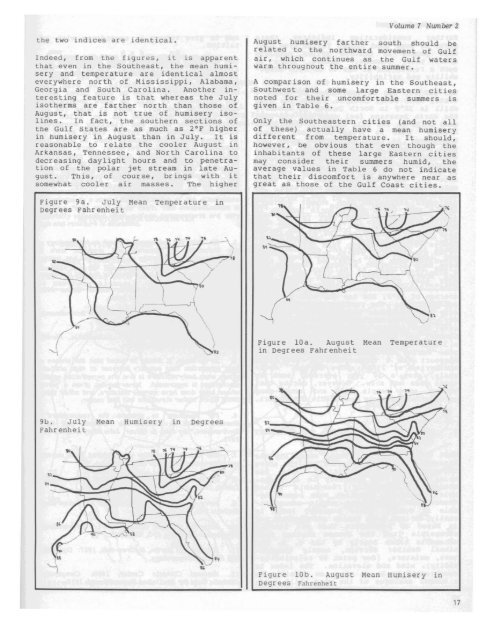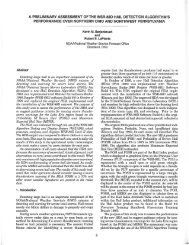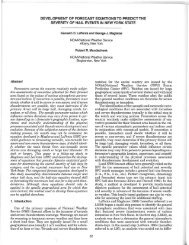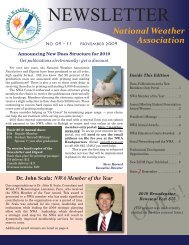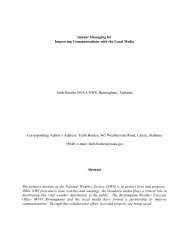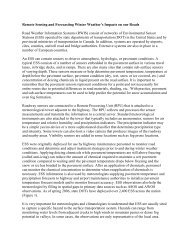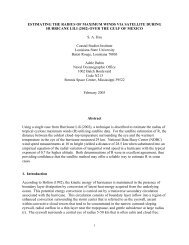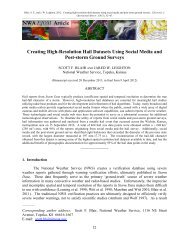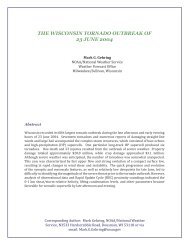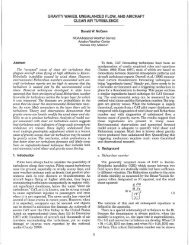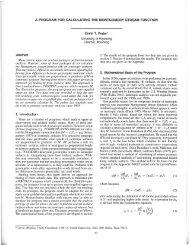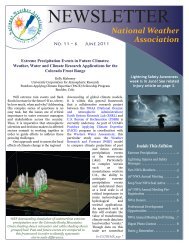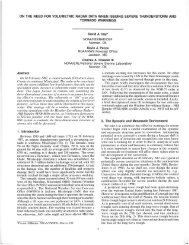The humisery and other measures of summer discomfort - National ...
The humisery and other measures of summer discomfort - National ...
The humisery and other measures of summer discomfort - National ...
Create successful ePaper yourself
Turn your PDF publications into a flip-book with our unique Google optimized e-Paper software.
Volume 7 Number 2<br />
the two<br />
indices are identical.<br />
Indeed, from the flgures, it is apparent<br />
that even in the Southeast, the mean <strong>humisery</strong><br />
<strong>and</strong> temperature are identical almost<br />
everywhere north <strong>of</strong> Mississippi, Alabama,<br />
Georgia <strong>and</strong> South Carolina. An<strong>other</strong> interesting<br />
feature is that whereas the July<br />
is<strong>other</strong>ms are far ther nor th than those <strong>of</strong><br />
August, that is not true <strong>of</strong> <strong>humisery</strong> isolines.<br />
In fact, the southern sections <strong>of</strong><br />
the Gulf States are as much as 2°F higher<br />
in <strong>humisery</strong> in August than in July. It is<br />
reasonable to relate the cooler August in<br />
Arkansas, Tennessee, <strong>and</strong> North Carolina to<br />
decreasing daylight hours <strong>and</strong> to penetration<br />
<strong>of</strong> the polar jet stream in late August.<br />
This, <strong>of</strong> course, brings with it<br />
somewhat cooler air masses. <strong>The</strong> higher<br />
August <strong>humisery</strong> farther south should be<br />
related to the northward movement <strong>of</strong> Gulf<br />
air, which continues as the Gulf waters<br />
warm throughout the entire <strong>summer</strong>.<br />
A comparison <strong>of</strong> <strong>humisery</strong> in the Southeast,<br />
Southwest <strong>and</strong> some large Eastern cities<br />
noted for their uncomfortable <strong>summer</strong>s is<br />
given in Table 6.<br />
Only the Southeastern cities (<strong>and</strong> not all<br />
<strong>of</strong> these) actually have a mean <strong>humisery</strong><br />
different from temperature. It should,<br />
however, be obv ious that even though the<br />
inhabitants <strong>of</strong> these large Eastern cities<br />
may consider their <strong>summer</strong>s humid, the<br />
average values in Table 6 do not indicate<br />
that their <strong>discomfort</strong> is anywhere near as<br />
great as those <strong>of</strong> the Gulf Coast cities.<br />
Figure 9a. July Mean Temperature in<br />
Degrees Fahrenheit<br />
Figure lOa. August Mean Temperature<br />
in Degrees Fahrenheit<br />
90. July Mean Humisery in Degrees<br />
Fahr enheit<br />
"<br />
Figure<br />
Degrees<br />
lOb. August<br />
Fahrenheit<br />
Mean Humisery in<br />
17


